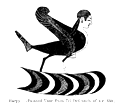Harpȳiae
(
Ἅρπυιαι). The Harpies were originally the goddesses of
the devastating storm, symbolizing the sudden and total disappearance of men. Homer only names
one of them (
Il. xvi. 150), Podargé, or “the
swift-footed,” who, in the shape of a mare, bore to Zephyrus the horses of Achilles.
In Hesiod (
Theog. 267) the Harpies appear as winged goddesses with beautiful
hair, daughters of Thaumas and Electra, sisters of Iris, with the names of Aëllo and
Ocypeté. In the later story their number increased, their names being
Aëllopus,
 |
|
Harpy. (Painted Vase from Tel-Defenneh of B.C. 650.)
|
Ocythoë, Nicothoë, and Celaeno. They are there
represented as half-birds, half-maidens, and as spirits of mischief. In the story of the
Argonauts, for instance, they torment Phineus by carrying off and polluting his food till they
are driven off by Calaïs and Zetes, and either killed or banished to the island of
the Strophades, where they are bound by an oath to remain. See Verg.
Aen. iii. 211-244.





